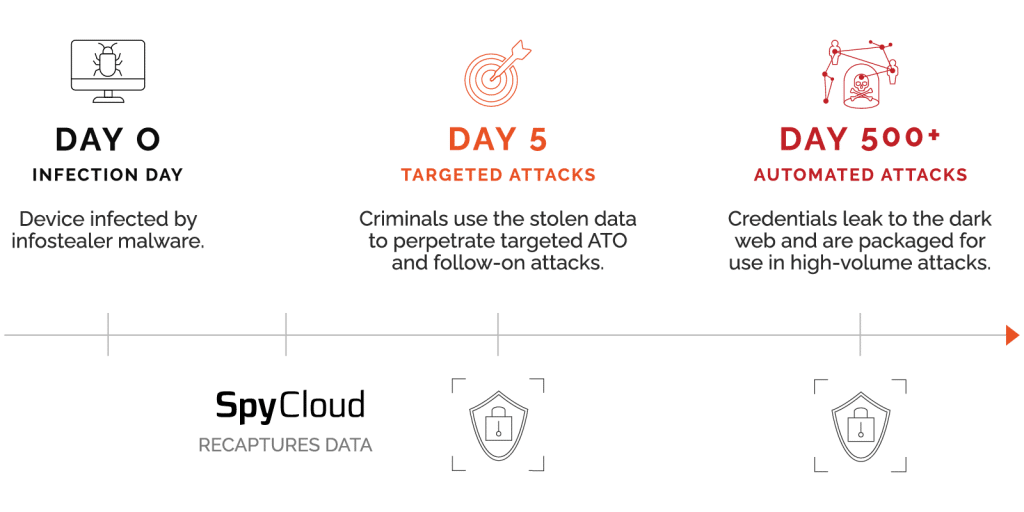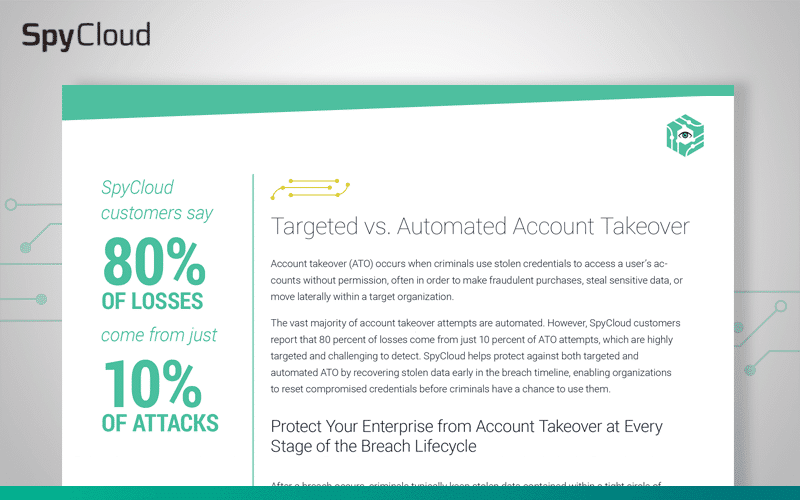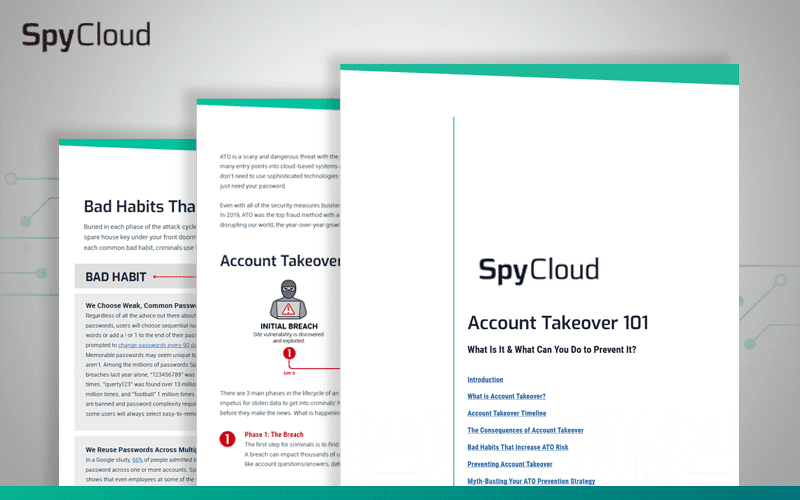What are targeted attacks?
SpyCloud Customers Say 80% of Losses Come from Just 10% of Attacks
All account takeover prevention solutions are not created equal. Many products, such as botnet firewalls and solutions that rely on commodity data, provide inadequate protection against the most damaging types of account takeover attacks. According to SpyCloud customers, 80 percent of losses come from just 10 percent of ATO attempts, which are highly targeted and challenging to detect.
SpyCloud helps enterprises protect themselves against both targeted and automated account takeover. By gaining access to breach data early in the breach timeline, SpyCloud enables organizations to detect and reset compromised credentials before criminals have a chance to perform a targeted attack such as account takeover, and follow-on attacks like ransomware and business email compromise.
Protect Your Enterprise from ATO at Every Stage of the Breach Lifecycle
After a breach occurs, criminals typically keep the data contained within a tight circle of associates while they determine how to monetize the data most effectively. Because few people have access to the data, stolen credentials are valuable assets for cyber targeting. This is when unsuspecting organizations and individuals become cyber attack targets —and this is also when SpyCloud researchers gain access to breach data.
The attackers and their associates systematically monetize stolen data over the course of about 18 to 24 months before gradually allowing credentials to leak to more public locations on the deep and dark web.
Once they become available to a broad audience, including “deep and dark web” scraping and scanning tools, the credentials become relatively low-value commodities. At this stage, passwords have been cracked and plaintext credentials have been packaged into “combolists,” which are lists formatted for use with automated account checker tools that make credential stuffing easy and accessible for unsophisticated criminals.

How do targeted cyber attacks work?
Let’s take a closer look at both types of attacks.
Targeted Account Takeover Attacks
Challenges for security teams:
Highly effective, difficult to detect, huge potential losses
Challenges for criminals:
Time-consuming, not scalable
Automated Credential Stuffing Attacks
Challenges for security teams:
Easy for unsophisticated criminals to launch high-volume attacks
Challenges for the criminal:
Easy to detect and prevent
Focus on Specific Companies or Individuals
After a data breach, a criminal and their associates evaluate stolen information and prioritize certain high-value individuals and organizations for targeted, manual attacks. They may take steps such as:
- Profiling wealthy or high-profile individuals
- Identifying C-level executives or developers with internal access to valuable corporate assets
- “Fingerprinting” a particular target organization to pinpoint defense thresholds and optimize target attack strategies
Target a Broad Range of Companies, Not Specific Individuals
A criminal engaging in automated credential stuffing attacks will target any company with active online accounts that they can attempt to take over and resell, trade, or otherwise monetize. Affected industries may include:
- Entertainment and multimedia services
- Food delivery
- Ecommerce and retail
- Travel and hospitality
- Education
- Professional software
- Healthcare
Research Targets and Find an Entry Point
The criminal acquires credentials and PII via methods such as:
- Purchasing credentials on the dark web
- Social engineering
- Locating open source info on the web
- Running a phishing scam
- Leveraging targeted malware that will record keystrokes on the target’s computer
- Using a cracking tool for a manual brute attack
Buy, Trade, or Scrape Combolists
The criminal acquires credentials and tools for credential stuffing:
- Purchase or acquire an account checker tool that is valid for one or more sites
- Purchase, scrape, or otherwise obtain a combolist, which is a large list of usernames, emails, and passwords that can be loaded into account-checker tools
- Less commonly, an attacker might rent C2 / botnet infrastructure on the dark web, usually for a timeframe of 24-72 hours, and acquire an account stuffer and cracker to install on each bot (slightly more sophisticated because it costs money)
Sophisticated and Varied Techniques
The criminal uses a variety of tactics, tools, and procedures to sidestep security measures and access accounts, such as:
- Combining manual checks and specialized tools like purplespray to take a “low and slow” approach, systematically testing password variations without raising alarms
- Bypassing MFA via phishing, social engineering, man-in-the-middle attacks, iCloud vulnerabilities, or session hijacking
- Thwarting SMS-based 2FA with SIM-swapping, phone porting, or exploiting vulnerabilities in cell infrastructure (SS7 network)
- Pivoting tactics swiftly in response to new targeted security measures
Unsophisticated, Uniform Tactics
The criminal uses their account checker tool to launch a credential stuffing attack against many accounts at one or more target organizations. If using botnet infrastructure, they will issue commands from the C2 server to launch credential stuffing attacks at mass scale.
Because companies block malicious IP addresses, the attacker will use one or more methods of getting around IP blocking while using the account checker, such as free proxies, a VPN, and/or using TOR.
Escalation Is Common
Having gained access to an account, the criminal may escalate privileges or use one compromised account to reach additional targets. Tactics may include:-
- Searching compromised email and storage accounts for TOTP seed backups or photos to use for authentication with other providers
- Cementing their ownership of an account by gradually changing contact info and other PII, locking the victim out of the account
- Using a victim’s stolen account for targeted attacks against friends, coworkers, or clients
- Leveraging extortion, blackmail, and social engineering to gain additional access or control
Escalation Is Uncommon
Attack escalation is less common from criminals leveraging automated attacks, particularly because they intend to exploit the accounts themselves or resell them.Achieve Targeted Objectives, Including High-Value Monetization
With access to stolen accounts, the criminal can:
- Create new accounts
- Open credit cards
- Place fraudulent orders
- Gain access to victims’ work accounts
- Conduct industrial espionage
- Wire or transfer money out of victims’ accounts
- Sell account access to other criminals
Monetize Large Numbers of Low-Value Accounts
With access to stolen accounts, the criminal can:
- Sell account access to other criminals
- Place fraudulent orders using credit card information or gift cards stored within accounts
- Commit warranty fraud using stored device information
- Change shipping addresses to facilitate package theft and drop-shipping
- Siphon loyalty points associated with the account
Without the SpyCloud data, we would be at constant risk for attacks we never saw coming.
ECOMMERCE
Top 10 Travel Booking Site Read the Case StudyFeatured Resources

Targeted vs. Automated Account Takeover Attacks
Account takeover can be highly-targeted, sophisticated, and manual, or it can be high-volume and automated. Learn how to protect your enterprise from both types of ATO.

Surviving a Data Breach – On-Demand
Security leaders who have been through worst-case scenarios offer real-world advice for stronger breach prevention & response. Get the audio file or watch the panel webinar on-demand.

Account Takeover 101
You can’t stop ATO until you understand it. Get this plain-English primer on the latest attack methods, bad habits that increase ATO risk, and strategies for prevention.
